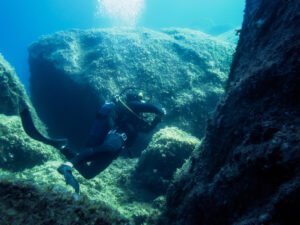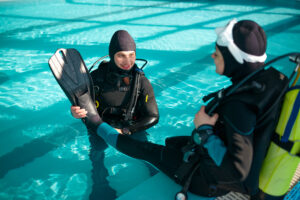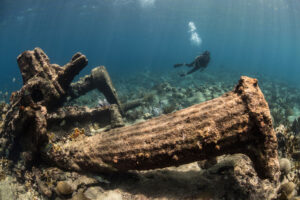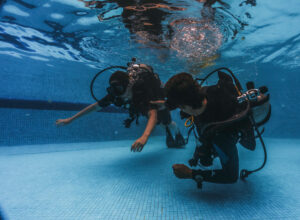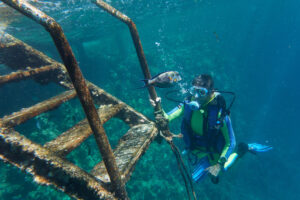What is a Personal Locator Beacon?
A Personal Locator Beacon (PLB) is a crucial device designed to enhance safety during scuba diving and other outdoor activities. This compact and portable gadget, typically small enough to fit in a pocket, emits a distress signal to alert rescue services in the event of an emergency. For divers, the PLB represents a vital lifeline, providing a reliable means of communication when other methods are unavailable or ineffective. By transmitting a signal that can be detected by satellites, PLBs significantly increase the chances of a successful rescue, particularly in remote or hazardous environments. Their importance in the world of scuba diving cannot be overstated.
Historical Development
The concept of locator beacons dates back to the mid-20th century, originally developed for maritime and aviation use. Early beacons were large, cumbersome devices primarily used on ships and aircraft to signal distress in emergencies. These devices operated on specific radio frequencies and required substantial power to transmit signals over long distances. The initial focus was on ensuring the safety of those traveling across vast and often treacherous waters or through the skies.
With technological advancements, locator beacons became more sophisticated and compact. The transition to satellite-based systems marked a significant milestone in their evolution. The advent of the COSPAS-SARSAT system in the late 1970s revolutionized search and rescue operations. This international satellite-based search and rescue initiative provided global coverage, enabling more accurate and timely responses to distress signals. As a result, the survival rates for those in peril significantly improved.
The development of the PLB specifically tailored for individual use came much later. By the early 2000s, advances in miniaturization and battery technology allowed manufacturers to create smaller, more portable devices suitable for personal use. This development was particularly beneficial for activities like scuba diving, where mobility and ease of use are paramount. Modern PLBs incorporate GPS technology, further enhancing their accuracy and reliability in emergency situations.
Technical Specifications
Personal Locator Beacons are equipped with several critical components that enable their functionality. At the core of a PLB is its ability to transmit a distress signal using specific radio frequencies, most commonly 406 MHz. This signal is picked up by satellites in the COSPAS-SARSAT system, which then relay the information to ground stations. The ground stations decode the signal and forward it to the appropriate rescue coordination center, ensuring a swift response.
One of the essential features of modern PLBs is the incorporation of GPS technology. This allows the device to transmit precise location data, significantly reducing the time it takes for rescuers to locate the individual in distress. The GPS coordinates are embedded in the distress signal, providing a clear and accurate location that can be pinpointed by search and rescue teams.
In terms of design, PLBs used in scuba diving must be waterproof and able to withstand significant pressure. These devices are typically rated to operate at depths up to 60 meters (196.85 feet), ensuring they function effectively underwater. Additionally, they are designed to be buoyant or neutrally buoyant, making them easier to handle in an underwater environment. The battery life of a PLB is another crucial factor; most devices are designed to operate for a minimum of 24 hours once activated, providing ample time for rescue operations to commence.
Operation and Mechanism
The operation of a Personal Locator Beacon is straightforward but highly effective. In an emergency, the user activates the device, typically by pulling a tab or pressing a button. This action breaks a seal and initiates the transmission of the distress signal. Once activated, the PLB begins to emit a 406 MHz signal, which is detected by satellites orbiting the Earth. The signal includes a unique identifier registered to the device, which helps rescuers determine the identity of the individual in distress.
The inclusion of GPS technology in modern PLBs means that the device also transmits precise location data. This information is crucial for search and rescue operations, as it allows rescuers to pinpoint the exact location of the individual. The signal is continuously transmitted, enabling rescuers to track the movement of the person if they are drifting in the water or moving from the original activation site.
Battery life and maintenance are critical aspects of PLB operation. Most devices are designed with long-lasting batteries that can remain dormant for years but provide continuous power for at least 24 hours when activated. Regular testing and maintenance are essential to ensure the device functions correctly when needed. Users should periodically test their PLB, following the manufacturer’s guidelines, to verify its operational status and ensure the battery is still viable.
Regulations and Standards
The use of Personal Locator Beacons is governed by international regulations and standards to ensure their effectiveness and reliability in emergency situations. One of the primary regulatory bodies is the International Maritime Organization (IMO), which sets standards for safety equipment used in maritime environments. PLBs must meet specific criteria set forth by the IMO, including operational depth, signal strength, and battery life.
Additionally, PLBs must comply with standards established by the International Cospas-Sarsat Programme, which oversees the satellite-based search and rescue system. Devices must be capable of transmitting signals that can be detected and processed by the COSPAS-SARSAT satellites. This includes adhering to the 406 MHz frequency standard and incorporating GPS technology for precise location tracking.
In many countries, local maritime authorities also impose regulations on the use and registration of PLBs. Registration is a critical component, as it ensures that each device is linked to specific user information. This information includes the user’s name, contact details, and emergency contacts, which are vital for rescuers to initiate and coordinate a rescue operation effectively. Failure to register a PLB can result in delays and complications during an emergency.
For scuba divers, compliance with these regulations and standards is particularly important. Divers must ensure that their PLBs are designed to operate at the depths they plan to reach and are maintained in accordance with the manufacturer’s recommendations. Proper registration and regular testing are also essential to ensure the device will function correctly when needed.
Practical Applications in Scuba Diving
In the context of scuba diving, Personal Locator Beacons serve as an essential safety tool, providing a critical line of communication in emergencies. There are several scenarios where PLBs prove invaluable. For instance, if a diver becomes separated from their group or vessel due to strong currents or poor visibility, activating the PLB can immediately alert rescuers to their location. This can be particularly crucial in remote diving locations where traditional means of communication may be unavailable.
Real-life examples highlight the effectiveness of PLBs in saving lives. In one notable case, a diver in a remote part of the Pacific Ocean became separated from their boat. After several hours drifting alone, they activated their PLB. The distress signal was quickly picked up by a satellite, and within hours, a rescue team was dispatched to their exact location. The diver was safely rescued, thanks to the timely activation and accurate location data provided by the PLB.
Recommendations for carrying and handling PLBs while diving are straightforward but important. Divers should always ensure their PLB is easily accessible and securely attached to their gear. The device should be positioned in a way that it can be activated with minimal effort, even in stressful situations. Additionally, divers should familiarize themselves with the operation of their PLB, conducting periodic tests to ensure it functions correctly. Proper training and knowledge can make a significant difference in the effectiveness of a PLB during an emergency.
Advantages and Limitations
Personal Locator Beacons offer numerous advantages, making them an indispensable tool for enhancing safety during scuba diving activities. One of the primary benefits is their ability to provide a reliable means of communication in emergencies, particularly in remote locations. The use of satellite technology ensures that distress signals can be detected globally, significantly increasing the chances of a successful rescue.
The incorporation of GPS technology in PLBs further enhances their effectiveness. By providing precise location data, these devices enable rescuers to pinpoint the exact location of the individual in distress, reducing the time required for rescue operations. This accuracy can be life-saving, particularly in scenarios where time is of the essence, such as when a diver is exposed to cold water temperatures or strong currents.
However, there are also limitations associated with the use of PLBs. One of the primary challenges is ensuring the device functions correctly underwater. While most PLBs are designed to be waterproof and pressure-resistant, their performance can be affected by factors such as depth, water salinity, and temperature. Divers must ensure their PLB is rated for the depths they plan to reach and is maintained according to the manufacturer’s guidelines.
Another limitation is the reliance on battery life. Although PLBs are designed to operate for a minimum of 24 hours once activated, users must ensure the battery remains viable over time. Regular testing and maintenance are essential to verify the device’s operational status. Additionally, divers should be aware that once activated, the PLB must remain on the surface to transmit signals effectively, which can be challenging in rough sea conditions.
Comparing PLBs with other safety devices, such as dive computers or Emergency Position-Indicating Radio Beacons (EPIRBs), highlights their unique advantages. While dive computers provide critical information about dive conditions and EPIRBs are suitable for use on vessels, PLBs offer a portable and personal solution for individual divers. This portability and ease of use make them an ideal choice for enhancing safety during scuba diving activities.
Key Takeaways
Personal Locator Beacons are essential tools that enhance safety for scuba divers, providing a reliable means of communication in emergencies. With their ability to transmit distress signals via satellite and incorporate GPS technology for precise location tracking, PLBs significantly increase the chances of successful rescues. Understanding their historical development, technical specifications, operation, regulatory requirements, and practical applications is crucial for divers to fully utilize these life-saving devices. Proper maintenance, registration, and familiarity with the operation of PLBs ensure they function effectively when needed, making them indispensable for safe diving practices.





